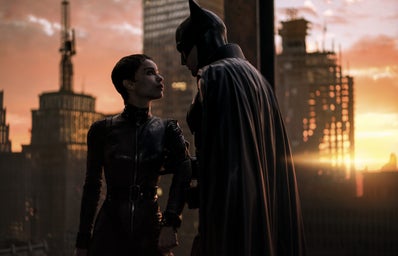Warning: Vague spoilers below.
Back in 2019, news headlines were flooded with the announcement that Robert Pattinson, the Twilight star, had been cast as the new Batman. This role is infamous for its range of actors, and even though I’ve seen my fair share of DC movies, I’m not an avid follower or fan. I knew Michael Keaton as the villain of Spider-Man: Homecoming and didn’t hear that Ben Affleck had been selected to try his turn in the suit until trailers came out. This news, however, reached well beyond the average DC fan. Even I had thoughts about the surprise casting.
Flash forward to the beginning of this month, with my boyfriend raving about the “best Batman movie yet” and Pattinson and Zöe Kravitz making a daily appearance on my Instagram page. I wasn’t counting down to The Batman’s release like I tend to do with the latest Marvel movie, so I was content waiting to see it whenever the opportunity arose, which turned out to be this past weekend. Within the first ten minutes, I’d firmly decided that Pattinson was born for the role.
My impression of DC is that it’s always catered toward the epitome of stereotypical masculine desire, lacking the audience appeal to those who didn’t fit the mold and hadn’t declared themselves dedicated fans before even watching the latest addition. Even as they attempted to compete with Marvel’s approach in their more recent films, their strive for blockbuster status combined with risks that fell short kept their stories unfulfilling. With The Batman, DC finally unlocked a method that successfully created a standout: they stopped trying. The creators of this version of Batman abandoned the model that’s been serving Marvel to the point that it’s nearly run dry and instead focused on their roots.
The character of Batman historically relies on an “unfriendly, neighborhood” approach, with his purpose intertwined with the city of Gotham. The latest round of superhero movies has escalated from global to universal threats, struggling to outdo themselves with each new challenge their heroes must overcome. Even the superheroes themselves have escalated to being actual gods or having the powers of the universe inside of them. The Batman presents a refreshing return to Earth, focusing on the problems of man, by man. Although Bruce Wayne is certainly not an everyday citizen, this take focuses on his drive to create difference rather than his intense riches, highlighting his humanity even more. Likewise, the villain is no universal creature that they must consult legends to defend against or understand, but a man hiding behind his mask of regularity.
To me, The Batman felt more like binging a series than watching a movie, reminding me of a season of The Alienist. In my opinion, that format would’ve suited the story better, giving it more time to delve into backstories and nefarious reasonings. This also would’ve made casual viewing and rewatching more appealing. Marvel movies are practically made for this with their bright colors, reliable narratives, recurring characters, comedic script and family-friendly audience. The Batman, on the other hand, doesn’t appeal to these qualities, instead sticking to a solemn, complex plot typical of DC, carried along by a slow string of crimes. However, as is, the detective-forward, crime-solving approach was well-suited to the classic Batman’s wheelhouse while still retaining the “bigger than us” idea often present from his villains.
This technique also allowed for another key distinction against other superhero movies that I appreciated: Batman embraced help. Too often, the phrase “I have to do this alone” comes up in superhero movies, signaling the character’s misguided sense of personalism in their fight, ignoring the bigger picture because their enemy targeted their ego. Even though Batman was singled-out specifically by the Riddler, he didn’t try to take on the burden alone and put others at risk in doing so. Instead, he praised the assistance his associates provided him and used their unique skills wisely. Although the chemistry between some of these characters was lacking, the potential annoyance caused by this was prevented by Batman continuously treating them like equals, all with something valuable to contribute, rather than designating himself their leader. In fact, he showed his leadership best by sacrificing himself, putting himself in danger for others’ benefit. This demonstrated his heroism far more effectively than being the only one with the ability to save the city or world ever could; it highlighted his humanism, his purpose and his influence.
As Batman valued his partners in the movie, The Batman separated itself from the Marvel template in a creator sense by valuing the various divisions of filmmaking. While it still featured major scenes that seemed to exist for the stereotypical male interest — a long car chase scene in particular — the cinematography, costume and set design, stunts and the overall lack of CGI reliance made the movie all the more satisfying and entertaining to viewers. This was especially impressive as The Batman managed to create a villain and storyline that was unsettling without being graphic, unlike Joker. By toying the line of psychological thriller, it created a film for older audiences without being exclusionary to younger interested individuals or those who dislike the horror genre, like myself. Although the color and lighting scheme made the movie appear even longer and tiring at times, the impressive imagery and uncompromising villainy throughout the film kept the audience happily engaged.
Overall, The Batman was a refreshing take on superhero films, making a return to the components of their original success by keeping local and human. It catered to devoted DC fans through cameos and casual viewers through their detective-like unveiling process. Although it followed the criticized Marvel practice of not proposing a solution to political-based issues, it differed in that it finished with a dubious optimism of gradual improvement. Pattinson’s Bruce Wayne demonstrated emotional complexity, grief, sorrow, guilt, admiration and intelligence in a humbling turn away from just relying on his riches. All in all, I’d watch it again when flipping through channels and encourage audiences to see it at least once, either to support variance in superhero action films or to celebrate Pattinson’s own, well-deserved, Andrew Garfield-esque revival.


